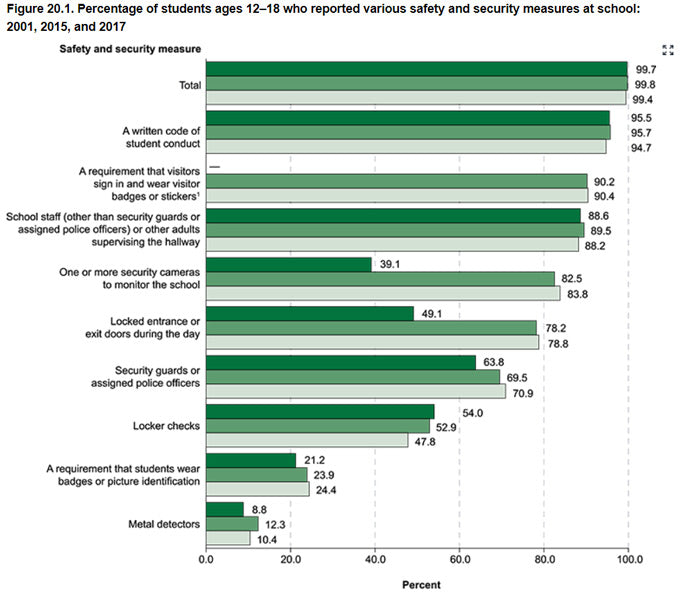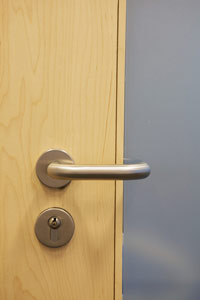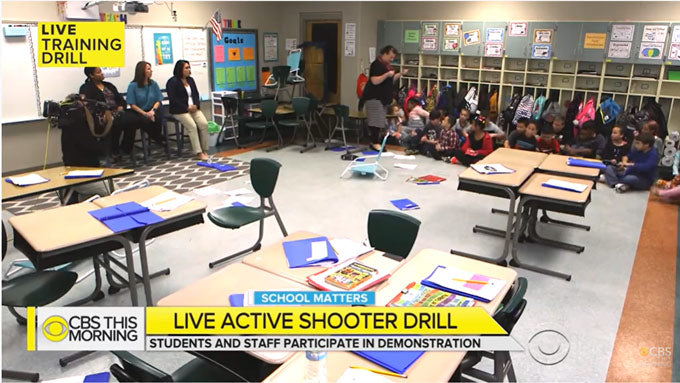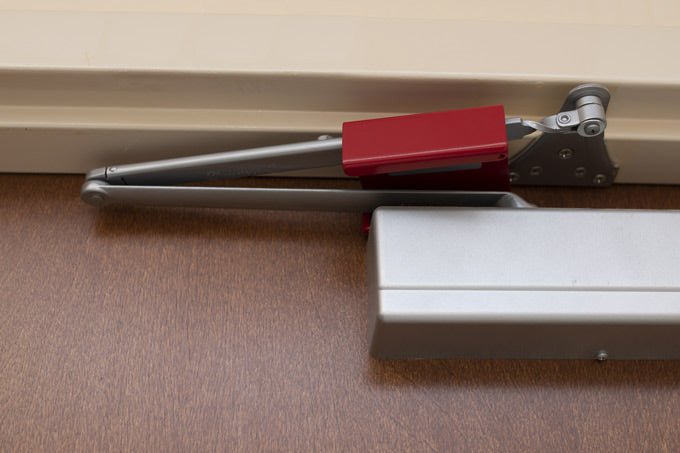Improving School Door Security For Emergencies
With most coronavirus lockdown measures lifting around the world, it’s once again time for school.
Students and teachers spend most of their time in classrooms. According to the National Center for Education Statistics, an average school day is 6.64 hours.
After school work, students attend clubs, and teachers help with extra-curricular activities. From ages five until 22, most Americans would spend their days in school.
This begs the question: how much security do we have in our schools?
According to the National Center of Education Statistics, schools have improved their security significantly since 2001.
Schools started installing metal detectors and hiring extra security guards. They have also started locking entrance and exit doors during the day.
If there is a threat, the most straightforward response is to prevent it from entering the schools. Aside from fire and earthquake drills, schools have been training with lockdown drills.

Source: U.S. Department of Justice, Bureau of Justice Statistics, School Crime Supplement (SCS) to the National Crime Victimization Survey, 2001, 2015, and 2017 | www.nces.ed.gov
Teachers and students train on how to secure classrooms to stop threats from entering classrooms. Training varies from simply locking the room to stacking chairs and desks to barricade it.
Door locking options in schools
Understanding how doors work in public spaces helps identify the appropriate response to any threat. What door locking options do students and teachers have in schools?
When it comes to school door security, schools need to follow strict building codes. Recommendations by the National Clearinghouse for Educational Facilities (NCEF) are also considered.
The NCEF was built by the National Institute of Building Sciences in 1998. Its purpose was to provide timely and comprehensive information on designing and building schools.
According to the NCEF, a school door must be able to control entry yet provide easy egress access in case of emergencies like fire and earthquake. It is a rule that a door should be able to prevent entry but must NEVER prevent people from exiting.

The International Building Code states school doors (and most public doors) should open out. Anyone can quickly exit a room by pushing through the doors. Outward-opening doors provide easy exit access without the trouble of knobs or locks.

In the case of locks, classroom doors must have outside locks. The idea is when the door is locked, no one can get into the classroom, but anyone inside the classroom can still get out without the need for a key.
Other types of door locks allowed in schools are electronically-controlled keyless door locks. It’s usually controlled in the school’s reception or security rooms. It can also be controlled with push-button codes, proximity cards, or biometric readers.
Should school doors be locked?
When there are occupants inside, school doors should not be locked. In case of emergencies like fire and earthquake, students and teachers must be able to exit the building quickly.
School doors can be locked from the outside to prevent any danger from coming in. Classroom door locks are designed to be outside of the door to ensure that occupants inside the room do not need to have a key to exit the room.
However, more and more schools are locking their doors as a precaution to external threats such as active shooter situations. Public schools in Spokane have started locking classroom doors to prevent access to active shooters.
Can teachers lock classroom doors?
Yes, teachers can lock classroom doors if an emergency happens. Especially if the emergency is to keep the danger from coming into the classrooms. An instance when classroom doors must be locked is during lockdown protocols.
During school hours and when there’s no emergency, classroom doors need to be unlocked. However, due to the increase in active shooter incidents in schools, there is a recommendation to keep classroom doors locked during on-going classes. Whether teachers are allowed to lock classroom doors, beyond lockdown protocols, depends on its school district’s policies.
Based on the Final Report of the Federal Commission on School Safety, classroom door locks in Parkland’s Marjory Stoneman Douglas (MSD) High School were a vulnerability during the shooting incident in 2018. Teachers had to go outside and expose themselves to the danger when locking the doors.
How much does it cost to install security door locks in school?
The installation of security door locks with labor averages from $875 to $1075 per door. A more affordable solution is getting lockdown devices such as The Sleeve, which only costs $83 per door.
Most school districts do not have a big budget to replace it with electronic door locks for schools. In some cases, the door locks are already pre-fitted, which would mean replacing the whole classroom door.
Colorado school districts spent $4 million to upgrade all door locks with a button function. The federal government invested $1 billion to improve school security through new architecture, design, and classroom door security systems.
In Michigan, a local school district spent $48 million to renovate schools and improve security. Tools such as gun-detection and impact-resistance windows and walls were added to schools, as well.
There’s no need to spend much and still get the security needed. The Sleeve is both effective and less expensive. It does not violate any building codes and will not require any renovations.
How do you secure a door?
The simplest way is to lock the door, but locking it doesn’t mean it’s entirely secured. When there is an immediate threat, barricading the door is the best way to secure it. Using The Sleeve can help secure doors safely and effectively within seconds.
Some training protocols suggest stacking chairs and tables against the door to barricade it. However, this practice is time-consuming, difficult, and brings a lot of attention to any threat from the outside.
This also requires multiple students and teachers to act together to do the barricade. Stacking chairs and tables are not ideal work for a class of primary school students.

Source: Screenshot from Here's what an active shooter drill for 4th graders looks like | CBS This Morning | YouTube
Another problem with stacking chairs and tables against doors is that it does not work well with outward-swinging doors. Most public doors cannot be barricaded by simply putting obstacles or heavy objects in their way. It’s essential to know how to barricade a door that opens out.
Securing classroom doors during high-tensed situations can be a challenge. Barricading the door should be easy and intuitive--just like The Sleeve. Anyone can secure the door within seconds, even if they’ve only used it for the first time.
How do you secure a door without a lock?
Some public doors are not fitted with locks to make sure access will never be blocked. These doors each have a door closer as mandated by the building and fire codes.
Barricading these types of doors may seem impossible, but it’s simple with The Sleeve. With its innovative design, The Sleeve can safely block anyone from opening outward-swinging doors even if it does not have a lock.

Using The Sleeve to lock a door without any locks.
What to Look for In a School Door Security Device
When looking for a door security device, you'll find that you have a bunch of options you can use during school lockdowns.
But before getting one of these, there are a few key factors that you need to consider first!
What to Look for In a School Door Security Device #1: Strength
What's the point of barricading a door if the shooter can just barge in?
Strength is the most critical thing to consider when choosing a school door security device.
But since most school doors are outward swinging, finding a device that is strong enough to hold the door closer in place can be a real challenge.
What to Look for In a School Door Security Device #2: Ease of Use
Let's say you have the strongest school door security device in the world.
So strong, that not even a tractor could mow it down.
Will you be safe during a school shooting?
Well, unless you can set it up before the shooter gets to your classroom, that mega strong school door security device is going to be useless.
Completely useless.
That's why getting a device that's extremely easy to use is critical.
When we're in fight or flight mode, our adrenaline pumps us extra energy, strength, and speed.
However, what it takes away from us is our fine motor skills.
That's why those mega-strong school security devices that require you to slip in a tiny pin into a tiny hole are no good.
Imagine trying to aim while your hands are shaking!
You'll end up like one of the victims in Hollywood movies where they endlessly fumble with their keys.
What to Look for In a School Door Security Device #3: Speed of Use
On the same note, your device also has to activate fast.
During active shooter events, every second counts.
The faster you can secure the door, the safer you and everyone in your classroom will be.
Ideally, your school door security device shouldn't take more than 2 seconds to deploy.
What to Look for In a School Door Security Device #4: Doesn't Violate Fire/ADA Codes
It would be a lot easier to lock your school door if it wasn't for fire and ADA codes.
However, while these codes are not so great during active shooter events, they are essential in others.
That's why when looking for a school door security device, you need to make sure you get one that doesn't violate these either.
Your security device needs to comply with the NASFM (National Association of State Fire Marshalls) guidelines, the Americans with Disabilities Act regulations, and the NFPA (National Fire Protection Association) guidelines as well (particularly NFPA 252 and NFPA 101).
What to Look for In a School Door Security Device #5: CISA-Certified
Lastly, you'll want a school door security device that is vetted and approved by the biggest security agencies in the country, such as CISA.
CISA, or Cybersecurity & Infrastructure Security Agency, is “the Nation's risk advisor,” and they work “with partners to defend against today's threats and collaborating to build more secure and resilient infrastructure for the future.”
While any manufacturer can claim that their school door security product is strong and reliable enough to keep an active shooter at bay, you know that devices with CISA certification are guaranteed to deliver.
What is The Sleeve?
The Sleeve is the ultimate outward-swinging door lockdown device.
It's:
- Super strong
- Super easy to use
- Super fast to use
- Compliant with fire and ADA codes
- CISA certified
Made from 12 gauge steel, the Sleeve is tough enough to lock your door closer in place.
No matter how hard you kick against the door, it just won't budge.
Plus, it's extremely easy to use.
All you have to do is slip it into the door closer arm, and you're done! (see below for video demonstration).
No matter how panic you are, you can secure your doors without any problems.
And with the Sleeve, it only takes all of 2 seconds to secure your door!
Talk about speed!
Since you don't have to permanently install anything, the Sleeve is compliant with fire and ADA codes.
And finally, if you're unsure of how good it is, the Sleeve is also CISA certified.
If the government trusts it, why shouldn't you?

How to use The Sleeve?
When there is an active shooter incident or intruder in the school, use The Sleeve in three easy steps.
- Step 1: Get The Sleeve.
- Step 2: Slide it over the door closer.
- Step 3: Get back and hide.
Source: The Sleeve by Fighting Chance Solutions | YouTube
During high-tense situations, quick actions can save lives. The Sleeve’s easy-to-use design gives more time for students and teachers to complete their lockdown protocols.
No need for multiple students to focus on barricading one door. It only takes one person to barricade the room.
More than the protection it provides, The Sleeve provides peace of mind to occupants in the room. When there’s a threat outside, students and teachers can rest easy that their classroom doors won’t open even when force is applied to it.
Another great advantage of using The Sleeve is that it’s affordable. For only $83, you can improve your school door security. There are no additional fees, such as installation costs and modifying or replacing your school’s current door.
And because there’s no further installation needed, using The Sleeve does not violate any building codes.
There’s no need to use it during class hours, keeping the doors unlocked. Use it when an alarm for an active shooter threat sounds off. Once the threat is gone, you can simply remove The Sleeve from the door closer. There wouldn’t be any damage to the school’s door from using it.
With so much time spent in school, it’s a priority to secure the safety of students and teachers. Nowadays, there’s a need to prepare for more than natural disasters. Increase your school door security now. Purchase The Sleeve for every outward-swinging door in your school. Prepare for any external threats like active shooters and intruders.



